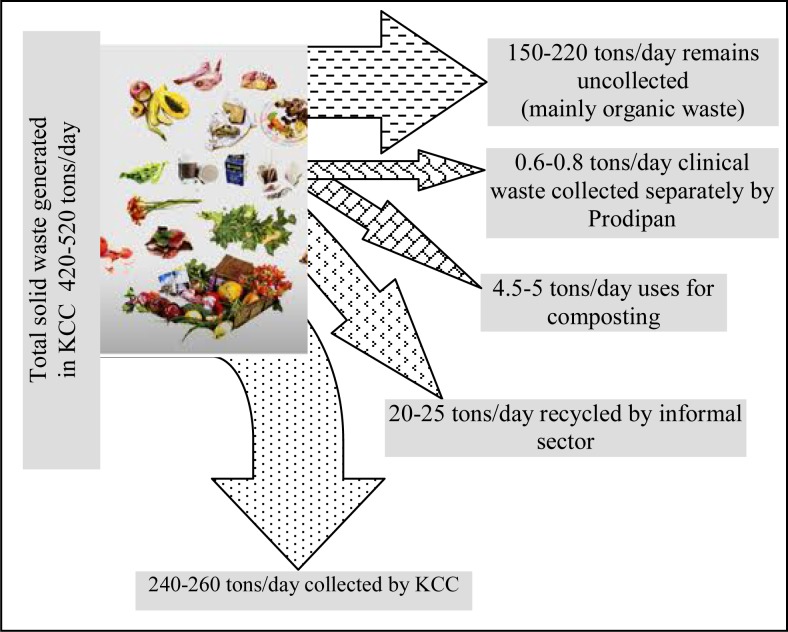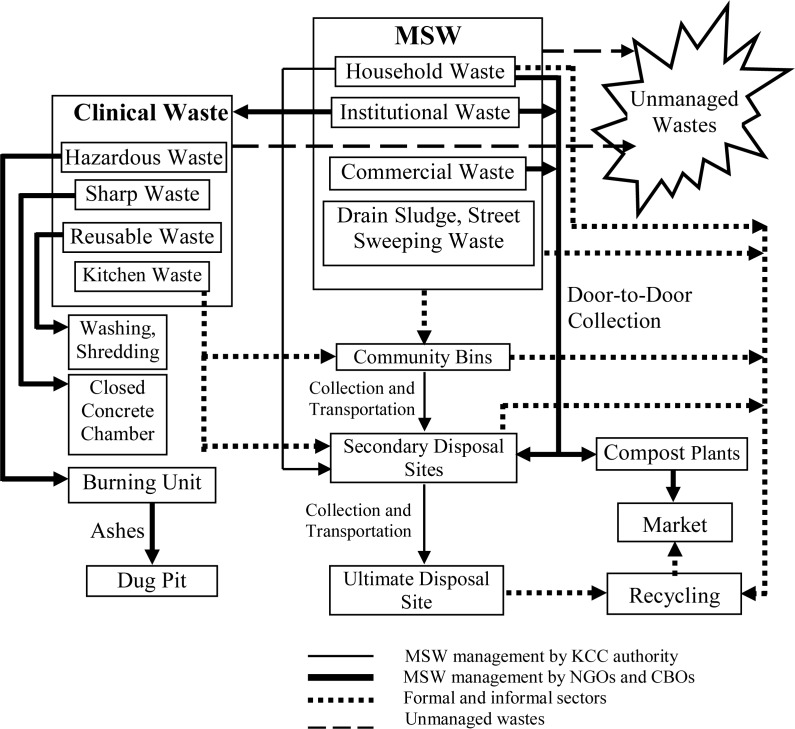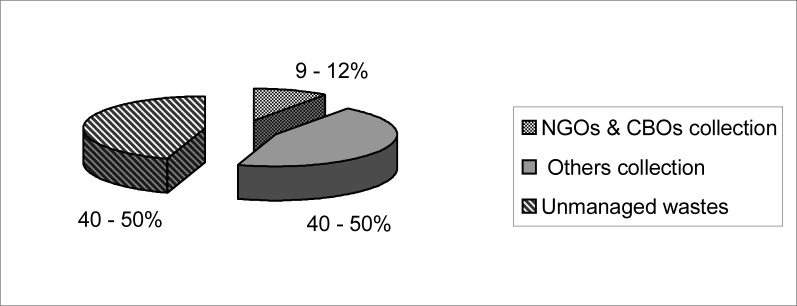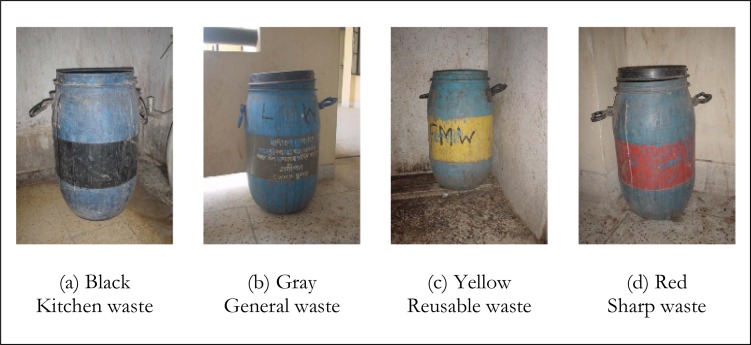Abstract
Background
Developing cities like Khulna, the third largest metropolitan city in Bangladesh, have now begun to confess the environmental and public health risks associated with uncontrolled dumping of solid wastes mainly due to the active participation of non-governmental organizations (NGOs) and community-based organizations (CBOs) in municipal solid waste (MSW) management.
Methods:
A survey was conducted to observe the present scenarios of secondary disposal site (SDS), ultimate disposal site (UDS), composting plants, medical wastes management and NGOs and CBOs MSW management activities.
Results:
A total of 22 NGOs and CBOs are involved in MSW management in 31 wards of Khulna City Corporation. About 9 to 12% of total generated wastes are collected by door-to-door collection system provided by mainly NGOs and CBOs using 71 non-motorized rickshaw vans. A major portion of collected wastes is disposed to the nearest SDS by these organizations and then transferred to UDS or to private low-lying lands from there by the city authority. A small portion of organic wastes is going to the composting plants of NGOs.
Conclusion:
The participation of NGOs and CBOs has improved the overall MSW management system, especially waste collection process from sources and able to motivate the residents to store the waste properly and to keep clean the premises.
Keywords: Municipal solid waste (MSW), NGO, CBO, Waste management, Composting
Introduction
Khulna City is located in the southwestern part of Bangladesh near the Sundarbans, the largest mangrove forest in the world (Fig. 1). It is situated below the tropic of cancer, around intersection of latitude 22.49° North and longitude 89.34° east. The total area of Khulna city corporation (KCC) is about 47 sq. km comprising 31 wards (1). It has been a place of commercial importance for more than 150 years. Khulna city grew rapidly due to the establishment of large and small-scale industries before and after independence of Bangladesh in 1971. Khulna is also famous for shrimp processing and exporting to overseas. For these reasons, Khulna is suffering a moderate pressure of migrated people from neighboring districts. It was reported that about 50% of the total population in Khulna is migrants, mostly employment purposes (2). Presently the population reaches to 1.5 millions, results a pile of garbage accumulated everyday and remains ill managed and creating enormous health and environmental hazards (3).
Fig. 1:
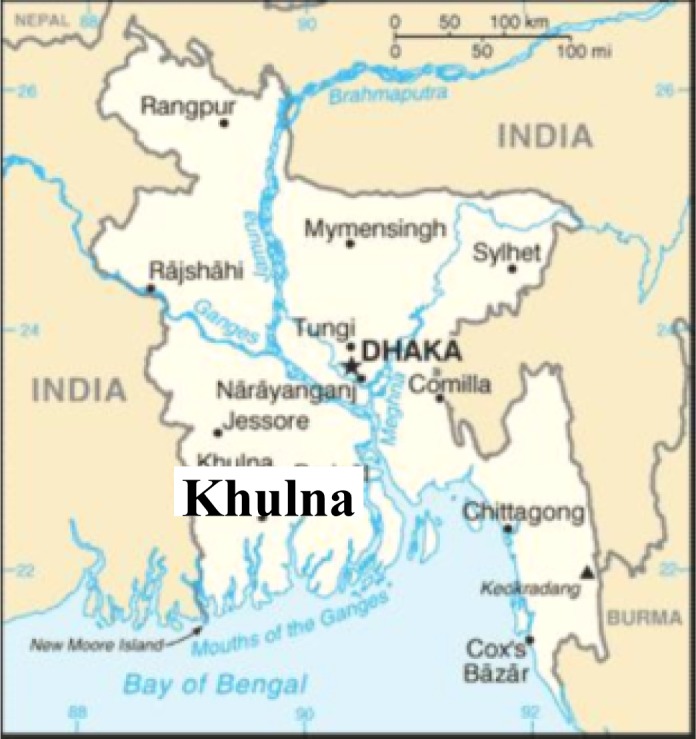
Location of Khulna City in Bangladesh
This paper describes the initiatives of non-governmental organizations (NGOs) and community based organizations (CBOs) in municipal solid waste (MSW) management in Khulna city. NGOs and CBOs mainly perform door-to-door collection system to collect MSW from different houses against tiny payment from the house owner who agrees to participate. In some cases, the service is also provided as free of cost. There are total 13 NGOs and 9 CBOs involved in MSW management at different wards of KCC. The city authority collects waste partially by door-to-door collection system only in ward 22. The total waste collection from generation sources by NGOs and CBOs is only 9 to 12% of total MSW generated in Khulna city. Three NGOs are involved in composting of organic wastes by running six composting plants situated in and around KCC areas. Prodipan is the only NGO involved in partial management of medical waste in Khulna City.
Materials and Methods
In Khulna City, a survey was conducted to find out the total number of NGOs and CBOs, their MSW management activities, and the present scenarios of secondary disposal sites and roadside open dumping. A few meetings were arranged with the conservancy department of the city corporation office to collect the data and information of MSW management. The ultimate disposal site of MSW at Rajbandha, Khulna was visited several times. The composting plant of Prodipan was also visited to observe the different steps of composting process involved and the compost product. The information of other composting plants of PRISM Bangladesh and RUSTIC was collected from their offices. The data of the medical wastes management was collected from the office of Prodipan since this NGO is solely responsible for medical wastes management in Khulna City. The burning unit (small incinerator) and concrete chamber for needle and sharp wastes at Rajbandha, Khulna were visited to observe the present scenario of treatment.
Results and Discussion
a). Present Scenario of MSW Management
Solid waste management has so far been ignored and least studied environmental issues in Bangladesh but recently the concerned stakeholders have begun to consider this area to be an inseparable component to protect human and nature from environmental hazards (4). KCC is responsible for the operation and maintenance of municipal services, including solid waste management. It is made up of 8 functional departments and the conservancy department is responsible for management, maintenance and monitoring of solid waste, street sweeping, public latrine and urinal, drain sludge, and street lighting.
Solid wastes collection from generation sources is mainly done by NGOs and CBOs in KCC. Door-to-door collection systems are adopted for wastes collection from generation sources and then dispose major portion of it to the nearest secondary disposal sites (SDSs). From there KCC vehicles collect the wastes and transport it to the ultimate disposal site (UDS) of KCC. Some NGOs transfer their collected organic wastes to compost plants. Whilst the city authority has some limited numbers of non-motorized rickshaw vans and hand trolleys those are mainly used for the collection of MSW from community bins (located at roadside, home side and near market) and transfer to SDSs. Besides, the drain sludge is also collected by these vans. The city authority collects waste partially from ward 22. In 1995, the city authority handed over a ward (ward 29) to a private company for the management of solid waste and drain sludge.
KCC vehicles collect wastes from SDSs (Fig. 2a) and transfer it to UDS for disposal at Rajbandha, 10 km far from the city center (Fig. 2b). This is the only UDS in Khulna and open dumping is practiced for ultimate disposal, as there is no controlled/engineered/sanitary landfill in Bangladesh (5). More than 60 SDSs are available in city area from where KCC vehicles collect wastes and approximately 1200 community bins, located on roadsides throughout the city. The city authority places some haul containers (HCs) and permanent concrete/masonry bins in SDSs.
Fig. 2:
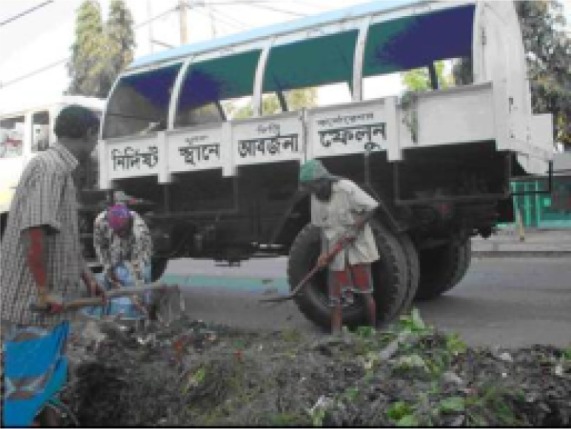
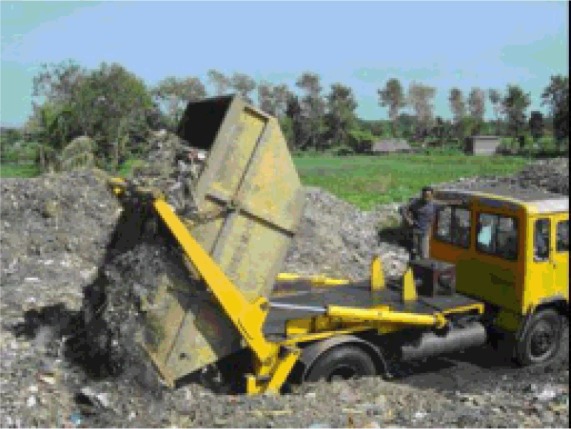
MSW collection and then disposal at Rajbandha, Khulna
(a) Collection from roadsides storage
(b) Open dump of wastes
KCC has 32 motorized and 266 non-motorized vehicles for waste collection and transportation. Only motorized vehicles are used for collection of wastes from SDSs and then transfer to UDS. Non-motorized vehicles are uses for transfer wastes from community bins to SDSs. Most recent study shows that the waste generation rate is 0.3–0.4 kg/capita/day and total generated MSW is varied from 420 to 520 tons/day in KCC. However, the collection capacity of KCC vehicles is 240 to 260 tons/day, which is about 50 to 55% of the total generation (3). The present waste stream in Khulna is shown in Figure 3. Details existing management system of MSW, MSW recovery potential, characterization of MSW, present situation of UDSs could be found in literature (6–9). The total generation amount and the physical composition of MSW in six major cities including Khulna are reported as well (10).
Fig. 3:
Waste stream in Khulna City
KCC faces lack of waste dumping area with its increasing urbanized wastes since it has only a UDS. Therefore, it is important to find out some other sites. The ecological footprint (0.088 ha/capita) was calculated to develop a sustainable waste management system by considering its existing solid waste characteristics (11). Seven suitable UDSs have been found by the multi-criteria evaluation method using Geographical Information System (GIS) approach in Khulna city. Each site has satisfied all the criteria adopted for highly suitable sites for MSW disposal (12).
b). NGOs and CBOs Initiatives
NGOs are providing a prominent support to informal sector waste workers and enterprises to organize themselves to improve working conditions and facilities, increase earnings, and extend access to essential social services such as health care and schooling for children in Khulna. Whilst privatization involves the transfer of management responsibility and ownership from the public to the private sector and has proved to be a powerful means of improving the efficiency of some waste management services such as collection, haulage and disposal. Operating in various forms of partnership with the public sector, they may provide capital, management and organizational capacity, labor and technical skills (13).
When any NGOs/CBOs are interested to involve MSW management, first they should consult with the Commissioner of the respective ward. Then, they may obtain the permission from the conservancy department of the city corporation office. A total of 22 NGOs and CBOs are involved in MSW management in different wards of KCC in cooperation with the city authority and respective ward Commissioner. Prodipan and PRISM (Project in Agriculture, Rural Industries, Science, and Medicine) Bangladesh are the two national NGOs initiated MSW management in Khulna city and provide financial support to other small NGOs and CBOs. Presently, they are not directly involved in waste collection. Their works distributed to partner NGOs and CBOs. They are, however, monitoring partner NGOs work and providing required suggestion to improve the management system.
Prodipan has been working in the southern and southwestern region of Bangladesh to improve the socio-economic condition since 1983 and involved in MSW management in Khulna city since 1998. Now Prodipan is also involved in hazardous waste management and composting. PRISM Bangladesh was established in 1989 and initiated garbage collection in 1997. Now PRISM Bangladesh is mainly involved in composting.
Another NGO, Rural Unfortunates Safety Talisman Illumination Cottage (RUSTIC) established in 1993 and initiated community based MSW management project in March, 1997. RUSTIC has been collecting waste from households since June 1997. Some other NGOs are also involved in waste management in Khulna city, namely, World Vision, Muktir Alo, Samaj Progoti Sangsta (SPS), Bangladesh Resource Improvement Center (BRIC), Rupayan, An Organization for Socio Economic Development (AOSED), Nabarun Shangsad, Proshanti and Center for Human Development (CHD). Some CBOs are involved as well in waste collection services, namely, Protisruti, GOTI, Ispahani Bananipara Community (IBC), SAMADAN, CLANSHIP, Nobo Jagoron, Ginna Para Community (GPC), Jubo Unnayan Sogngatan (JUS) and Commitment (14–21).
c). Role of NGOs and CBOs
NGOs and CBOs are mainly involved in the collection of wastes from different generation sources, e.g. houses, markets, restaurants, and hotels. Then, they dispose the collected wastes to the nearest SDSs. However, only a few NGOs handle the composting of organic wastes and medical waste management in Khulna City, i.e. CBOs are not involved with these potential sectors until now.
Collection system
In KCC areas, collection of wastes from generation sources is mainly executed by NGOs and CBOs. Door-to-door collection systems are adopted for waste collection and then dispose major portion of it to the nearest SDSs (Fig. 4 and 5). Some NGOs transfer the collected wastes to compost plants. Most of the NGOs collects waste from household and receive tiny payment from the dwellers as collection charge. Fig. 6 shows the flow diagram of involvement of different agencies in the collection, transfer, and disposal of MSW in Khulna.
Fig. 4:
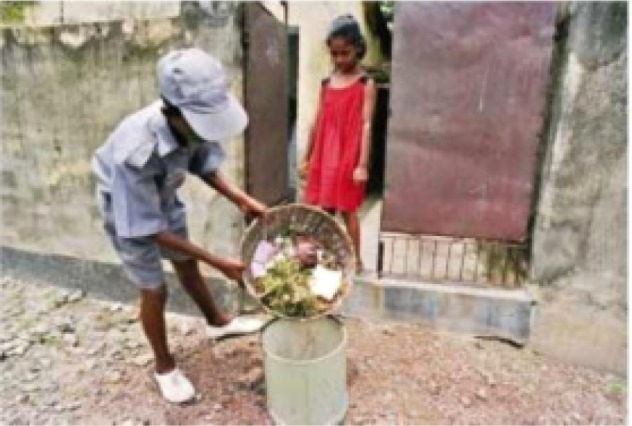
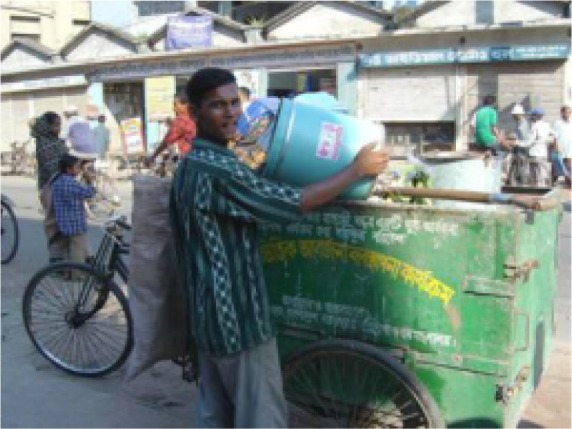
Door-to-door wastes collection by NGOs and CBOs
(a) Collection from houses (22)
(b) Storing waste inside a van
Fig. 5:
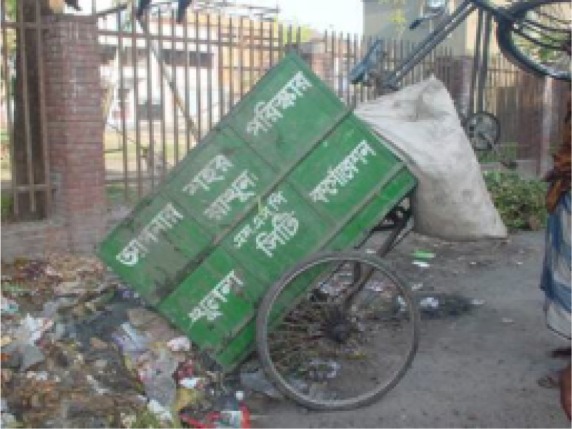
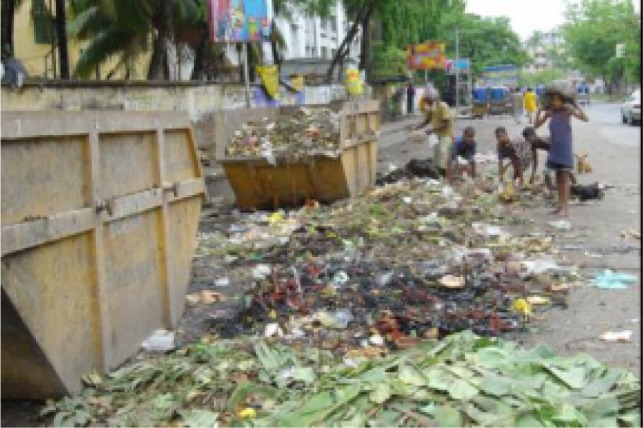
Discarding collected wastes to roadsides
(a) Discarding waste from van to roadside
(b) Waste outside of haul containers
Fig. 6:
Involvement of different agencies in MSW management in Khulna City
Collection facility
There are total 71 non-motorized rickshaw vans of NGOs and CBOs to operate the collection system. A driver and a helper are assigned for each van and the collection generally occurs daily for 9 hours (8 am to 5 pm) from residential sources as well as some offices. Table 1 shows the household coverage for waste collection, total vehicle capacity, manpower involvement, and monthly expenditure in MSW management of NGOs and CBOs engaged in KCC.
Table 1:
Details of NGOs and CBOs involvement in MSW management in Khulna City
| SL No. | Status | Name of NGOs/CBOs | Year** | Working area (Ward No.) | Household (no.) | Van (no.) | HR | Expenditure (Tk./Month) |
|---|---|---|---|---|---|---|---|---|
| 1 | NGOs | Prodipan | 1998 | Not specified | - | - | 13 | 26000 |
| 2 | PRISM B. | 1997 | Not specified | - | - | 12 | 24000 | |
| 3 | RUSTIC | 1997 | 17 and 18* | 4200 | 8 | 18 | 32000 | |
| 4 | Muktir Alo | 1998 | 21 and 23 | 1400 | 6 | 10 | 11600 | |
| 5 | SPS | 2001 | 9, 14, and 15 | 1550 | 6 | 10 | 14000 | |
| 6 | BRIC | 2001 | 3*,4,5,6*,7 and 8* | 1377 | 4 | 9 | 11300 | |
| 7 | Rupayan | 2001 | 19 and 20 | 2000 | 5 | 12 | 15900 | |
| 8 | AOSED | 1997 | 25 and 26 | 1485 | 5 | 11 | 16000 | |
| 9 | Nabarun S. | 1997 | 24 and 27* | 1500 | 7 | 12 | 15900 | |
| 10 | CHD | 2000 | 16 | 500 | 3 | 7 | 9100 | |
| 11 | World Vision | 2001 | 18* | 1400 | 5 | 12 | 15000 | |
| 12 | Shabolombi | 2001 | 10 | 950 | 3 | 8 | 10000 | |
| 13 | Proshanti | 2001 | 30 | 1200 | 4 | 9 | 10000 | |
| 14 | CBOs | Protisruti | 2002 | 22 | 900 | 2 | 5 | 7000 |
| 15 | GOTI | 2000 | 20* | 420 | 1 | 2 | 3500 | |
| 16 | IBC | 2002 | 1* and 2* | 820 | 2 | 5 | 7500 | |
| 17 | SAMADAN | 2004 | 8* | 800 | 2 | 5 | 8000 | |
| 18 | CLANSHIP | 2004 | 16* and 17* | 400 | 1 | 2 | 3000 | |
| 19 | Nobo Jagoron | 2004 | 16* | 200 | 1 | 2 | 3000 | |
| 20 | GPC | 2002 | 31* | 1200 | 3 | 7 | 10000 | |
| 21 | Commitment | 2003 | 11 | 450 | 1 | 2 | 3000 | |
| 22 | JUS | 2002 | 31* | 860 | 2 | 5 | 8000 | |
| Total | 23,612 | 71 | 153 | 2,05,800 |
Note: HR-Human Resource (people);
Partially;
Starting year of involvement in MSW management in Khulna; 1 US$ ≈ 70 Tk.
Collection efficiency
In Khulna City, total households are 1, 72,000 in (1). NGOs and CBOs are collecting wastes from approximately 24,000 households. Most recent study shows that the total generated MSW is varied from 420 to 520 tons/day (3) in Khulna city, in which only 240 to 260 tons are transferred and disposed from SDSs to UDS by the city authority. The amount of waste collection from sources and disposed to SDSs by NGOs and CBOs is 40 to 50 tons/day, which is 9 to 12% of total generated MSW (Fig. 7).
Fig. 7:
MSW collection from generation sources
In addition, a small portion is collected from sources by the city authority and a private organization. Some householders drop their waste to secondary points as well. The remaining wastes are either dumped to roadsides or remain unmanaged. In this collection process, 71 vans are working daily without any day-off. Generally, each van provides double trip per day having an approximate capacity of 270 kg/van/trip.
d). NGOs Involvement in Composting
Three NGOs are involved in Khulna city for composting of organic wastes through six composting plants situated in and around KCC areas. Among them PRISM Bangladesh operates four plants while Prodipan and RUSTIC, each operates a plant. The amount of organic waste consumed in these six plants is varied as 4.5–5 tons/day. Details of the composting plants are given in Table 2.
Table 2:
Details of composting plants
| Name of NGOs | No. of plants | Plant size (m2) | Land ownership | Maturation period (days) | Unit price (Tk./kg) | Manpower involved (people) | Special provsion |
|---|---|---|---|---|---|---|---|
| PRISM Bangladesh | 4 | 892 | Self | 50 | 6 | 3 | Wastewater treament project |
| 360 | Self | 50 | 3 | ||||
| 360 | Self | 50 | 3 | ||||
| 540 | Self | 50 | 3 | ||||
| Prodipan | 1 | 670 | KCC | 60 | 6 | 5 | - |
| RUSTIC | 1 | 2700 | Self | - | - | - | Vermi-composting |
Composting plant of PRISM Bangladesh
PRISM Bangladesh involved in composting process from June 2001. Partner NGOs supplied the collected daily wastes to its four plants. The daily consumption of organic waste is varied from 800–1000 kg/plant. Other materials such as cow dung, wood ash and sawmill dust are also used in these plants during the process of composting to improve the quality of product. The commercial name of the compost of PRISM Bangladesh is known as Sobuj Sona (Green Gold), which is sold as 6 Taka, per kilogram (Tk. /kg).
Composting plant of Prodipan
Prodipan involved in composting of MSW since 2001. The compost plant is situated in a corner of the UDS at Rajbandha, Khulna. The organic wastes are collected directly from households as well as from the UDS. The consumption of organic waste is varied from 600–900 kg/day. In this plant, a small percentage of cow dung, chemical fertilizer [e.g. Urea and triple superphosphate (TSP)] and sawmill dust are used with organic wastes to produce good quality compost. The production cost of compost is 4 Tk. /kg and the selling price is 6 Tk. /kg. Fig. 8a shows the drying process of organic wastes in the composting plant of Prodipan and the final product, i.e. compost is shown in Fig. 8b. The land of composting plant is owned by KCC. Prodipan signed a memorandum with KCC for temporarily using the land.
Fig. 8:
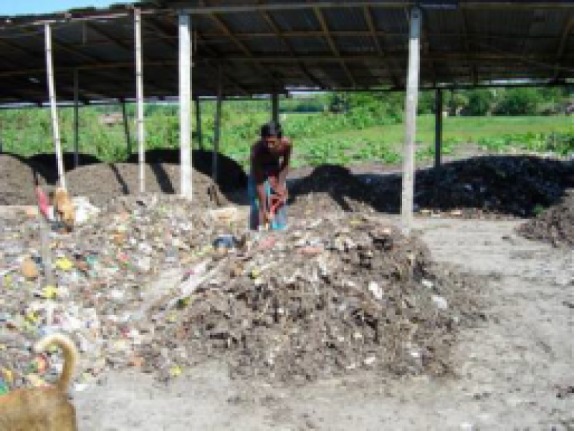
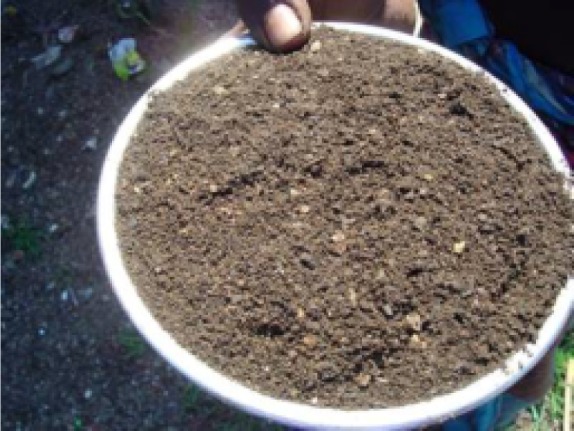
Composting plant of Prodipan in Rajbandha, Khulna
(a) Drying of organic wastes
(b) Final product (compost)
Composting plant of RUSTIC
In 2001, RUSTIC started a small-scale compost plant as a pilot project in a land of KCC near a locality in the city. The initial production capacity was 245 kg in a period of 45 days. Van pullers transfer the collected wastes to the plant in which the organic portion was used for composting. In 2004, the city authority ordered to stop the plant due to strong public complains of bad odor. After that, all collected wastes are disposed to nearby SDSs. The new compost plant of RUSTIC is constructed at its own land in Rajbandha. A special provision of the new plant is vermicomposting. Vermicomposting is the process of using worms and microorganisms to turn organic waste into black, earthy-smelling, nutrient-rich humus.
e). NGOs Involvement in Medical Waste Management
Presently hospital/medical wastes management is one of the major problems in Bangladesh, due to its hazardous effect on human and nature and form of mismanagement practices. There are more than 129 hospitals, private clinics, and pathological laboratories in Khulna City. Among them 5 are government hospitals, 59 are private clinics and 65 are different types of pathological laboratories. Prodipan initiated medical waste management project in 2000 and 47 hospitals, clinics and pathological laboratories are under their services. Among them 2 are government hospitals, 35 are private clinics and 10 are pathological clinics. The wastes collection from these institutes is about 700 kg/day whereas the total generated medical waste is about 2200 kg/day. Only 32% of total generated medical wastes are collected and then managed by Prodipan.
Various types of waste such as food and vegetable (kitchen) waste, medicine strip, used gauge, cotton, tissue, organs, syringe, saline bag, blade and needle are collected from 47 institutes (hospitals, clinics and pathology laboratories). Prodipan provides four plastic containers of different colors (Fig. 9) in clinics for the storage of waste.
Fig. 9:
Containers for the storage of clinical wastes
The selected colors are (i) Black for kitchen waste, (ii) Gray for general hospital waste, (iii) Yellow for non-sharp or reusable waste and (iv) Red for sharp waste. The wastes are separated by the users/nurses at the source in 4 different categories such as needle and sharp parts, reusable wastes, surgical wastes and kitchen wastes. Kitchen waste is disposed with other MSW in nearby SDSs. The reusable wastes are shredded and stored for recycling after cleaning. Needle and sharp wastes are encapsulated in a 7 ft deep concrete chamber. Remaining general medical wastes are burned in a locally made burning unit (Fig. 10) and the residues are then disposed ultimately in a nearby pit. Prodipan monthly charges 150–300 Tk./pathological lab and 100–600 Tk./clinic for their services (23). Four people (supervisor, driver, helper for a car and worker for waste sorting process) are assigned for medical wastes collection and management.
Fig. 10:
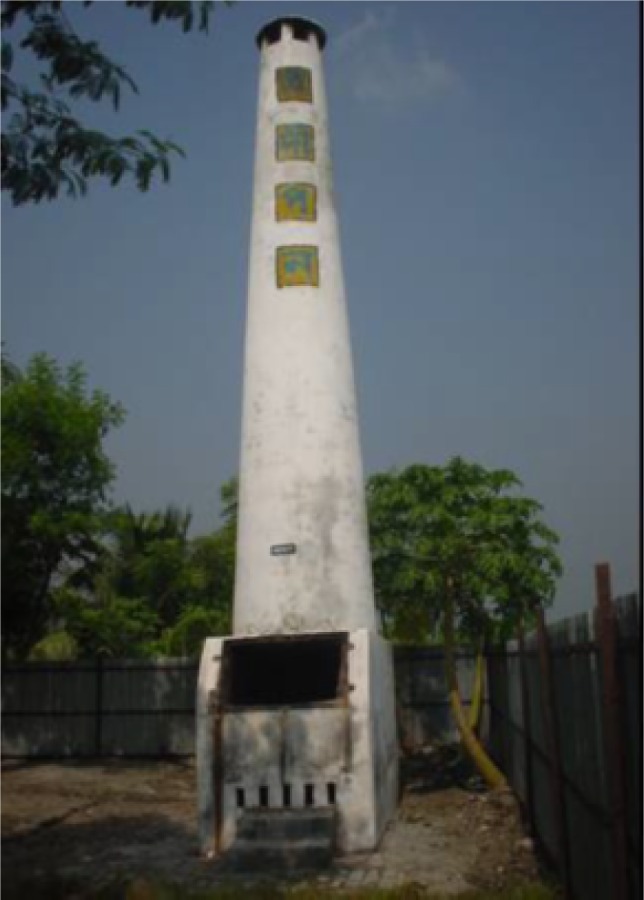
Burning unit
f). Recycling
Recycling is the key mechanism to recover useful products and reduction in waste quantity. However, NGOs/CBOs are not directly involved in this potential sector. A few researches on recycling have been conducted in Khulna City. Swapan (24) researched on the socio-economic aspects of solid waste recovery and recycling in Khulna city. He focused on the type of inorganic waste collected by the scavengers, their socio-economic status and the informal recycle chain of the waste (collected by the scavengers) to be recycled. Moniruzzaman et al. (25) focused on the current recycling practices of solid waste in Khulna City.
g). NGOs and CBOs Concerns and Complications
Table 3 shows the comparison of different MSW management activities before and after participation of NGOs/CBOs in Khulna City. Despite achieving noticeable success in waste collection by door-to-door collection system from generation sources, NGOs and CBOs have been facing many multi-dimensional problems, which can be summarized as:
As the van pullers and helpers get tiny salary, there is a lack of sincerity and punctuality to perform the duty properly.
The service charge collection is a common problem for all NGOs and CBOs. On an average 20% of households is not paying or delaying the payment as per the agreement.
NGOs and CBOs do not have any big vehicles to collect and transfer. They are not able to buy as well due to the financial constraint. The collected wastes are, therefore, usually disposed to SDSs, i.e. on roadsides.
In SDSs, waste is discarded outside of the bin due to lack of sufficient bin and due to few technical problems such as size, shape, location, and design aspects of bins. The spreading of waste creates environmental pollution and reduces traffic passage.
The marketing of compost product is a great concern of NGOs, as the market of compost is not yet fully established.
Non-motorized rickshaw vans require frequent repairing and finally out of service after 4–5 years. A big amount of money is required to buy new vans to continue the service. Therefore, a continuous financial support is required for its operation and maintenance.
Sometimes an irregular and weak participation of city/ward authority with NGOs and CBOs creates unwanted situation and terminate the MSW management system temporarily.
Due to lack of public awareness, motivation, and commitment, people do not cooperate as desired. Even the cooperation from some ward commissioners is not encouraging.
NGOs and CBOs are only involved in a part of MSW management, therefore they may not be able to change the overall scenario as desired by city dwellers.
Table 3:
Comparison of different MSW management activities before and after participation of NGOs/CBOs
| MSW management activities | Before participation of NGOs/CBOs | After participation of NGOs/CBOs |
|---|---|---|
| MSW collection from sources and transfer to SDSs | Residents had to bring the waste to the nearest SDS | Mostly done by NGOs and CBOs. Door-to-door collection system was launched by them. |
| Composting of organic wastes | No composting plant was found | Six composting plants are now managed by NGOs |
| Medical/hospital waste management | This waste was not properly managed | Prodipan handles this waste to manage it properly. A burning unit and a concrete chamber have been constructed by Prodipan. |
| People awareness and motivation | Residents had no/little awareness to store the waste properly | NGOs and CBOs have been trying to motivate the residents to store the waste properly and to keep clean the premises. They have regular motivation activities, e.g. campaign, rally, demonstration, and visiting schools, slum and residential areas. |
| City authority/local government | The city authority was not very conscious to manage the MSW properly | NGOs and CBOs have succeeded to bring the full attention of the city authority in this sector. A large numbers of NGOs and CBOs involvements show the importance to manage it properly. |
| Recycling | Residents had no/little awareness to separate the waste for recycling | Nowadays residents are interested for recycling due to the movements of NGOs and CBOs. The numbers of hawkers are increased as well who buy some items from houses, e.g. plastic, leather, newspaper, and glass bottle. |
Conclusions
In Khulna city, the participation of non-governmental organizations (NGOs) and community-based organizations (CBOs) has improved the municipal solid waste (MSW) management system in some aspects, e.g. collection process from sources and able to create much awareness among the people about the responsibility to cooperate in these striking social and environmental issues. A total of 22 NGOs and CBOs are mainly involved in collection of wastes from generation sources and discard to secondary disposal sites, composting of organic wastes and hospital/medical waste management. There are six composting plants are in operation now, however, the technical and environmental conditions are not at the required level. A potential sector to reduce the amount of waste generation is recycling. This sector is, however, not touched yet by these organizations. To have an integrated management and safe disposal system to handle MSW, continuous and effective support from city authority, city dwellers, and the concerned stakeholders should be extended to the NGOs and CBOs involved in this sector.
Ethical considerations
Ethical issues (Including plagiarism, Informed Consent, misconduct, data fabrication and/or falsification, double publication and/or submission, redundancy, etc) have been completely observed by the authors.
Acknowledgments
The support provided in this research by Asia-Pro Eco Programme of the European Commission, Contract Number- ASIA PRO ECO-ASI/B7-301/2598/16-2004/79010 is gratefully acknowledged. The assistance given by the NGOs and CBOs working in Khulna city is also acknowledged. Thanks to all WasteSafe members for their cooperation during this study. Special thanks to Mr. Khaled H. Chowdhury for his cooperation and suggestion during the drafting stage of this article. The authors declare that there is no conflict of interests.
References
- 1.BBS. 2001. Bangladesh Bureau of Statistics Pocket Book. Dhaka, Bangladesh.
- 2.KDA. 2002. Report of Khulna Development Authority (KDA). Khulna, Bangladesh.
- 3.KCC. 2005. Feasibility Study on Municipal Solid Waste Management in Khulna City. Study Report, A feasibility project under the Asia Pro Eco Programme of EC, Department of Civil Engineering, Khulna University of Engineering and Technology, Khulna, Bangladesh.
- 4.Alamgir M, McDonald C, Roehl KE, Ahsan A. Integrated Management and Safe Disposal of Municipal Solid Waste in Least Developed Asian Countries-A Feasibility Study. WasteSafe Publication; Khulna, Bangladesh: 2005. [Google Scholar]
- 5.Alamgir M, Ahsan A, McDonald CP, Upreti BN, Islam R. Present Status of Municipal Solid Waste Management in Bangladesh. Proc. International Conference on ‘Waste-The Social Context’; May 11–14; Alberta, Canada. 2005. pp. 11–20. [Google Scholar]
- 6.Alamgir M, Ahsan A, Mohiuddin KM. Existing Management of Municipal Solid Waste in Khulna City of Bangladesh. Proc. International Conference on ‘For a Better Tomorrow: Sustainable Solid Waste Management in Developing Countries’; January 11–13; Kathmandu, Nepal. 2006. pp. 1–10. [Google Scholar]
- 7.Alamgir M, Ahsan A. Municipal Solid Waste and Recovery Potential: Bangladesh Perspective. Iranian Journal of Environmental Health Science and Engineering. 2007;4(2):67–76. [Google Scholar]
- 8.Alamgir M, Ahsan A. Characterization of Municipal Solid Waste and Nutrient Contents of Organic Component in Bangladesh. Electronic Journal of Environmental, Agricultural and Food Chemistry. 2007;6(4):1945–1956. [Google Scholar]
- 9.Alamgir M, Mohiuddin KM, Czurda KA, Glawe U, Karim MR. Situation of Ultimate Disposal Sites of Municipal Solid Wastes in Bangladesh. Proc. International Conference on ‘Waste-The Social Context’; May 11–14; Alberta, Canada. 2005. pp. 27–35. [Google Scholar]
- 10.Alamgir M, Bidlingmaier W, Glawe U, Martens J, Sharif LA, Visvanathan C, Stepniewski W. Safe and sustainable management of municipal solid waste in Khulna city of Bangladesh. Proc. Eleventh International Waste Management and Landfill Symposium; 1–5 October 2007; Sardinia, Italy. 2007. pp. 1–10. [Google Scholar]
- 11.Salequzzaman M, Sultana UT, Iqbal A, Hoque MA. Ecological footprint of waste generation: a sustainable tool for solid waste management of Khulna city corporation of Bangladesh. Proc. International Conference on Complex Systems; June 25–30; Marriott Boston Quincy, Boston, MA, USA. 2006. pp. 1–12. [Google Scholar]
- 12.Rahman MM, Sultana KR, Hoque MA. Suitable sites for urban solid waste disposal using GIS approach in Khulna city, Bangladesh. Proceedings of the Pakistan Academy of Sciences. 2008;45(1):11–22. [Google Scholar]
- 13.Visvanathan C, Trankler J, Gongming Z, Joseph K, Basnayake BFA, Chiemchaisri C, Kuruparan P, Norbu T, Shapkota P. Municipal Solid Waste Management in Asia. 2004. Asian Regional Research Program on Environmental Technology (ARRPET), Asian Institute of Technology, Thailand, 45–57.
- 14.AOSED. Khulna, Bangladesh: 2003. Profile of an Organization for Socio Economic Development (AOSED) [Google Scholar]
- 15.BRIC. Annual Report and Profile of Bangladesh Resource Improvement Center (BRIC) Khulna, Bangladesh: 2003. [Google Scholar]
- 16.Muktir Alo (2002). Profile and Brochure of Muktir Alo. Khulna, Bangladesh.
- 17.Nabarun Shangsad (2003). Profile of Nabarun Shangsad. Khulna, Bangladesh
- 18.PRISM (2002). Brochure of Project in Agriculture Rural Industries Science and Medicine (PRISM). Bangladesh, Khulna, Bangladesh
- 19.Rupayan (2003). Brochure of Rupayan. Khulna, Bangladesh
- 20.RUSTIC. 2003. Annual Report and Brochure of Rural Unfortunates Safety Talisman Illumination Cottage (RUSTIC). Khulna, Bangladesh.
- 21.SPS. 2003. Profile and Brochure of Samaj Progoti Sangsta (SPS). Khulna, Bangladesh.
- 22.WSP. Community based pilot project on solid waste management in Khulna city: General project description. 2000. pp. 1–6. Water and Sanitation Program, Khulna, Bangladesh, Khulna City Series, 1.
- 23.Alamgir M, Chowdhury KH, Hossain QS. Management of Medical Wastes in Khulna City. Proc. Seminar on The Role of Renewable and Alternative Energy Sources for National Development; 19–20 December; KUET, Khulna. 2003. pp. 146–155. [Google Scholar]
- 24.Swapan M. Socio-economic aspects of solid waste recovery and recycling in Bangladesh: A case study of Khulna city. Proc. The Annual Conference of Australian Sociological Association; 1–4 December; The Australian National University, Canberra, Australia. 2009. pp. 1–14. [Google Scholar]
- 25.Moniruzzaman SM, Bari QH, Fukuhara T. Recycling practices of solid waste in Khulna city, Bangladesh. The Journal of Solid Waste Technology and Management. 2011;37(1):1–15. [Google Scholar]



